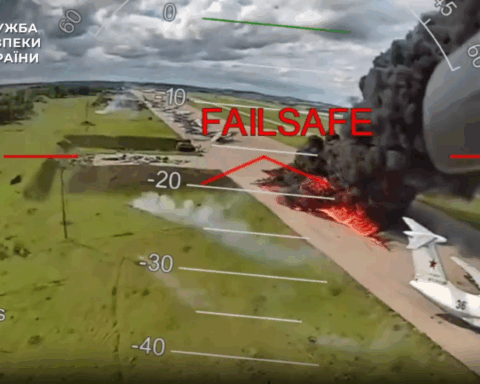WASHINGTON — The scale of Russia’s looting of Ukraine has become clearer with new photos indicating Russian theft of hazardous materials from a site near Chernobyl’s nuclear power plant, and another image from Belarus adding to evidence that Russian soldiers mailed looted goods home.
VOA has obtained exclusive photos of a nuclear laboratory from which a Ukrainian official says Russian troops stole radioactive material that could be harmful if mishandled.
The nuclear lab seen in the previously unpublished photos is located in the city of Chernobyl. It is housed in a building run by a state agency managing the exclusion zone around Chernobyl’s nearby decommissioned nuclear power plant, where a 1986 explosion caused the world’s worst nuclear accident.
The director of the agency, Evgen Kramarenko, provided the laboratory photos to VOA, saying he took them on an April 5 visit, five days after Russian troops withdrew from Chernobyl. They had occupied the city and the nuclear power plant on February 24 at the start of Russia’s full-scale invasion of Ukraine.
“We have a laboratory that had a big quantity of radioactive instruments that are used to calibrate our radiation dosimeters,” Kramarenko told VOA. A dosimeter is a safety device, typically worn by individuals as a badge, that measures exposure to ionizing radiation, including nuclear radiation.
The agency’s dosimeters are calibrated using small metallic containers of radioactive material made by Ukrainian state enterprise USIE Izotop, which displays a photo of them on its website.

“Most of those calibration instruments were stolen. They look like coins. If the Russian soldiers carry them around, it’s very dangerous for them,” Kramarenko said.
Belarus-based science journalist Siarhei Besarab told VOA that the small size of the instruments may make them appear innocuous to the uninformed observer.
“But if a person comes into direct contact with them, these kinds of instruments could cause radiation burns to the skin in as little as two minutes,” Besarab said.
The photos shared by Kramarenko show a room with blue-colored walls containing computers and other equipment. It is part of a lab known as an Ecocenter whose functions include improving the management of radioactive nuclear waste.
The lab opened in 2015 and cost $6 million to build with support from the European Union, according to a March 22 Facebook post by the Ukrainian agency.
In Kramarenko’s photos, one of the lab’s computers can be seen lying on the floor with its contents removed and another can be seen tilted over on a desk, with other items strewn about on desks and on the floor.


Another photo shows a machine called an automated spectrometer, with its glass compartment and cabinet doors opened.

The agency had published several photos of the nuclear lab as it appeared prior to the Russian occupation in its March 22 Facebook post. The dates of those images were not shown.
In one of the pre-occupation photos, the same automated spectrometer seen in Kramarenko’s April 5 photo can be seen in its normal state, with its glass compartment and cabinet doors closed.

In another pre-occupation photo, a separate red-and-gray colored machine can be seen in its normal state. A close-up of one of Kramarenko’s April 5 photos in which the same machine is visible reveals that some of its parts are missing.


In a Saturday Facebook post, Kramarenko’s agency said occupying Russian troops stole samples of fuel-containing materials from the lab in addition to the radioactive calibration instruments. The agency said it was possible that the Russians threw away the items elsewhere in Chernobyl’s exclusion zone, but that a likelier scenario is that they kept items as “souvenirs.”
Kramarenko said the Russian troops also took computer servers and memory units from his agency’s building. He shared additional April 5 photos showing a gutted-out computer server rack cabinet with wires dangling and close-ups of computers with internal parts removed.


Apparent Russian looting in the city of Chernobyl extended beyond the nuclear lab, Kramarenko said. “They took our construction vehicles including trucks and excavators and for some reason, they also took plates and bed mattresses.”
Russia has been silent on what its troops did in Chernobyl since their pullout.
Separately, VOA has obtained a photo indicating that Russian troops who recently withdrew from Ukraine to neighboring Belarus, a Russian ally, used a Belarusian delivery company on at least three days this month to send items apparently looted in Ukraine to homes in Russia.
Lithuania-based exiled Belarusian dissident Anton Motolko sent VOA a photo that he said was taken by a source in the southern Belarusian city of Mazyr on April 4, showing what appears to be a Russian military truck painted with a “V” symbol commonly used by Russian troops. The truck is parked outside the local office of the CDEK delivery company and a person dressed in military uniform is seen next to the vehicle.
VOA could not independently verify the date of the photo, which Motolko requested not to be published to avoid endangering the source.
Motolko, who founded the Belarusian Hajun project news site, had first reported that Russian soldiers were seen unloading items from military trucks outside of the same CDEK office on April 1. He later posted on YouTube a three-hour-long video that he said was taken from a camera in the CDEK office on April 2, showing Russian soldiers bringing in household items, some of them unboxed and unwrapped, and proceeding to wrap and box them for mailing to their homes in Russia.
The unboxed, unwrapped items brought into the office include a video card, an electric scooter, liquor bottles and a car battery.
The footage from the CDEK office camera had been live-streamed on the website of the CDEK Mazyr branch. CDEK live-streams video from its delivery offices as a courtesy to customers to show them how busy the offices are, before customers visit the branches.
Exiled Belarusian news site Zerkalo said in an April 4 report that it contacted the CDEK Mazyr branch and confirmed that the Hajun project’s YouTube video had been taken from the CDEK branch’s live stream on April 2.
The Hajun project YouTube video, posted April 3, quickly went viral, provoking outrage among web users who labeled the Russian troops using the delivery company as marauders who should face trial.
Independent Russian news site Mediazona has reported that the CDEK Mazyr branch live-stream was cut off on April 4, corresponding to the date that Motolko said the Russian truck was photographed outside the office. It said the video stream resumed on April 5.
Since then, there have been no more reported sightings of Russian troops using the CDEK Mazyr office to deliver suspected looted Ukrainian goods to Russia.
Speaking to VOA, Motolko said the items seen being brought into the CDEK office for mailing on April 2, some of them already boxed, were unlikely to have been purchased by the Russian soldiers in Belarus.
“If they bought those things in Belarus, residents of small towns in the region would have noticed them buying all those items in stores,” he said, adding that he has been communicating with such residents regularly via email and messaging apps.






